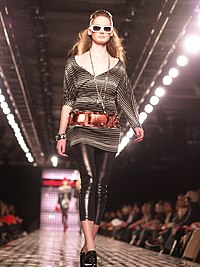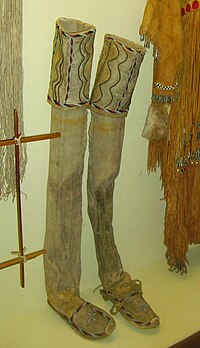Traveling within the World
Linking your favorite traveling artists across the globe
Leggings
Leggings are a type of fitted clothing covering the legs, which can be worn by both men and women.
Originally leggings were two separate garments, one for each leg.
Modern leggings are typically made from a blend of lycra, Spandex, nylon, cotton, or polyester blend, but they can also be made from wool, silk and other materials. Leggings are available in a multitude of colours and decorative designs.
Leggings are sometimes worn fully exposed, and are more traditionally worn partially covered by a garment such as a skirt, a large t-shirt or shorts, or fully covered by an outer garment, such as a full length skirt. Leggings are typically ankle-length, and some are stirrupped or encase the feet. Some are shorter. Leggings are worn to keep a person's legs warm, as protection from chafing during an activity such as exercise or as a decorative or fashion garment. Leggings are worn by both men and women in an exercise situation, but predominantly by women outside such situations.
In contemporary usage, leggings refers to tight, form-fitting trousers that extend from the waist to the ankles. In the United States, they are sometimes referred to as tights. However, the two words are not synonymous as the word tights refers to opaque pantyhose.
History
Leggings in various forms and under various names have been worn for warmth and protection by both men and women throughout the centuries. The separate hose worn by men in Europe from the 14th to 16th centuries (the Renaissance period) were a form of leggings, as are the trews of the Scottish Highlands. Separate leggings of buckskin leather were worn by some Native Americans. These were adopted by some Long Hunters, French fur trappers, and later by mountain men. They are the leatherstockings of James Fenimore Cooper's Leatherstocking Tales. The Buckskins, were mostly a dull grey brain-tan, not the bright, glossy vegetable tanned leather commonly used today.
Cowboys wore leggings of buckskin to protect from chapping caused by riding, wear and tear to their pants, and bites from animals, such as snakes or insects in the scruff, such as ticks.
In many places, especially in colder countries such as: Russia or Korea men and women continued to wear wool leggings into modern times, often as an additional outer layer for warmth.
The linen pantalettes worn by girls and women under crinolines in the mid-19th century were also a form of leggings, and were originally two separate garments. Leggings became a part of fashion in the 1960s, as trousers similar to the capris pants but much tighter. Fashion designer, Patricia Field, claimed, while advertising on the Home Shopping Network, that she invented the modern leggings for women in the late 1970s.
It was not until the fitness and aerobics craze in the very early 1980s that leggings became fashionable as gym-styled street wear for women. Leggings were worn in the 1980s through the mid-1990s with skirts, and short dresses like babydoll dresses, oversized shirts, sweaters, etc., and with slouch socks and Keds.
Tags:
Replies to This Discussion
Events
-
2014 is the Chinese Year of the Horse
February 17, 2026 at 12am to February 5, 2027 at 12am – where & how you choose
Birthdays
Birthdays Tomorrow
Important (read & understand)
Skype: Travelingraggyman
Email and Instant Messenger:
TravelerinBDFSM @ aol/aim; hotmail; identi.ca; live & yahoo
OR
Travelingraggyman @ gmail and icq ***

1AWARD UPDATES & INFORMATION
10,000 votes - Platinum Award
5,000 votes - Gold Award
2,500 votes - Silver Award
1,000 votes - Bronze Award
300 votes - Pewter Award
100 votes - Copper Award
Member of the Associated Posting System {APS}
This allows members on various sites to share information between sites and by providing a by line with the original source it credits the author with the creation.
Legal Disclaimer
***************We here at Traveling within the World are not responsible for anything posted by individual members. While the actions of one member do not reflect the intentions of the entire social network or the Network Creator, we do ask that you use good judgment when posting. If something is considered to be inappropriate it will be removed
Site Meter
This site is strictly an artist operational fan publication, no copyright infringement intended
Patchwork Merchant Mercenaries had its humble beginnings as an idea of a few artisans and craftsmen who enjoy performing with live steel fighting. As well as a patchwork quilt tent canvas. Most had prior military experience hence the name.
Patchwork Merchant Mercenaries.
Vendertainers that brought many things to a show and are know for helping out where ever they can.
As well as being a place where the older hand made items could be found made by them and enjoyed by all.
We expanded over the years to become well known at what we do. Now we represent over 100 artisans and craftsman that are well known in their venues and some just starting out. Some of their works have been premiered in TV, stage and movies on a regular basis.
Specializing in Medieval, Goth , Stage Film, BDFSM and Practitioner.
Patchwork Merchant Mercenaries a Dept of, Ask For IT was started by artists and former military veterans, and sword fighters, representing over 100 artisans, one who made his living traveling from fair to festival vending medieval wares. The majority of his customers are re-enactors, SCAdians and the like, looking to build their kit with period clothing, feast gear, adornments, etc.
Likewise, it is typical for these history-lovers to peruse the tent (aka mobile store front) and, upon finding something that pleases the eye, ask "Is this period?"
A deceitful query!! This is not a yes or no question. One must have a damn good understanding of European history (at least) from the fall of Rome to the mid-1600's to properly answer. Taking into account, also, the culture in which the querent is dressed is vitally important. You see, though it may be well within medieval period, it would be strange to see a Viking wearing a Caftan...or is it?
After a festival's time of answering weighty questions such as these, I'd sleep like a log! Only a mad man could possibly remember the place and time for each piece of kitchen ware, weaponry, cloth, and chain within a span of 1,000 years!! Surely there must be an easier way, a place where he could post all this knowledge...
Traveling Within The World is meant to be such a place. A place for all of these artists to keep in touch and directly interact with their fellow geeks and re-enactment hobbyists, their clientele.
© 2024 Created by Rev. Allen M. Drago ~ Traveler.
Powered by
![]()

